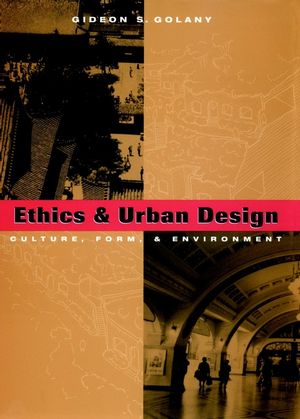Ethics and Urban Design: Culture, Form, and EnvironmentISBN: 978-0-471-12274-6
Hardcover
272 pages
August 1995
 This is a Print-on-Demand title. It will be printed specifically to fill your order. Please allow an additional 10-15 days delivery time. The book is not returnable.
|
||||||
"The city," according to urban design scholar Gideon Golany, is"the largest and most complicated project ever produced byhumankind." In Ethics and Urban Design, he challenges designprofessionals to reexamine their basic assumptions about the urbanenvironment and offers design strategies based on enduring humanvalues.
In search of answers to the paradoxical problems of the moderncity, Golany takes the reader through the sweep of humansettlements from the dawn of civilization to the present. Hisauthoritative examination of the genesis of the city is illuminatedby instructive examples of early urban centers. Mesopotamia, theIndus River Valley, the Egyptian cities of the Nile, and thecapital cities of ancient China--all are examined in the light ofwhat made them work as major centers of human activity.
What Golany finds in the success stories of the past are cohesivesociocultural values that shaped the design of homes,neighborhoods, and cities. These ethical values helped to maintainan equilibrium within the society that permeated its natural,social, and human-made environments. In the present era,conversely, he finds a major disconnection between human values andthe ethics of technology, which has resulted in confusion,imbalance, and dehumanization.
To help designers gain a perspective on possible solutions, Golanyexplains leading comprehensive design strategies, including thevalley theory, the urban border zone concept, and the regionalconcept of Patrick Geddes. In the case study of contemporaryHolland, he details what a small, densely populated country hasbeen able to achieve through design planning rooted inenvironmental ethics.
"Future Frontiers for Urban Design," the culminating section ofthis groundbreaking book, opens with Golany's vision of the futurecity. He examines the issues of thermal performance and climate asthey relate to urban design and offers the concept of"geospace"--the earth-enveloped habitat. Buttressing hispresentation with detailed information on the mechanics ofgeospace, Golany describes case studies of the successful use ofearth-enveloped habitats in China and Tunisia. He makes a powerfulargument for the geospace city as a renewal of ancient traditionsthat can restore the vital equilibrium between nature and humansettlements that we seem to have lost.
Ethics and Urban Design is a distinguished scholar's analysis andprescription for the city; it offers an abundance of stimulatingideas for the architects, designers, and planners who have assumedresponsibility for its future.
Ethics & Urban Design draws on historical examples andcontemporary case studies from around the world to illustrate urbandesign strategies that can help restore equilibrium to the natural,social, and built environments of the city. In this stimulatingbook, urban design scholar Gideon Golany offers architects,designers, and planners both an in-depth analysis of thefundamental issues of urban design and practical options for thedesign of the future city.
* Examines the genesis and development of the city from theearliest presettlements to the rise of urban society
* Presents urban design strategies based on historical examples ofearly urban centers, including Mesopotamia, the Indus River Valley,Egypt, and China
* Offers case studies of environmental success stories from Europe,Asia, and Africa
* Details geospace design options--the use of underground space fordiversified land use, housing, and transportation
* Fully illustrated, with over 80 photographs, drawings, anddiagrams
In search of answers to the paradoxical problems of the moderncity, Golany takes the reader through the sweep of humansettlements from the dawn of civilization to the present. Hisauthoritative examination of the genesis of the city is illuminatedby instructive examples of early urban centers. Mesopotamia, theIndus River Valley, the Egyptian cities of the Nile, and thecapital cities of ancient China--all are examined in the light ofwhat made them work as major centers of human activity.
What Golany finds in the success stories of the past are cohesivesociocultural values that shaped the design of homes,neighborhoods, and cities. These ethical values helped to maintainan equilibrium within the society that permeated its natural,social, and human-made environments. In the present era,conversely, he finds a major disconnection between human values andthe ethics of technology, which has resulted in confusion,imbalance, and dehumanization.
To help designers gain a perspective on possible solutions, Golanyexplains leading comprehensive design strategies, including thevalley theory, the urban border zone concept, and the regionalconcept of Patrick Geddes. In the case study of contemporaryHolland, he details what a small, densely populated country hasbeen able to achieve through design planning rooted inenvironmental ethics.
"Future Frontiers for Urban Design," the culminating section ofthis groundbreaking book, opens with Golany's vision of the futurecity. He examines the issues of thermal performance and climate asthey relate to urban design and offers the concept of"geospace"--the earth-enveloped habitat. Buttressing hispresentation with detailed information on the mechanics ofgeospace, Golany describes case studies of the successful use ofearth-enveloped habitats in China and Tunisia. He makes a powerfulargument for the geospace city as a renewal of ancient traditionsthat can restore the vital equilibrium between nature and humansettlements that we seem to have lost.
Ethics and Urban Design is a distinguished scholar's analysis andprescription for the city; it offers an abundance of stimulatingideas for the architects, designers, and planners who have assumedresponsibility for its future.
Ethics & Urban Design draws on historical examples andcontemporary case studies from around the world to illustrate urbandesign strategies that can help restore equilibrium to the natural,social, and built environments of the city. In this stimulatingbook, urban design scholar Gideon Golany offers architects,designers, and planners both an in-depth analysis of thefundamental issues of urban design and practical options for thedesign of the future city.
* Examines the genesis and development of the city from theearliest presettlements to the rise of urban society
* Presents urban design strategies based on historical examples ofearly urban centers, including Mesopotamia, the Indus River Valley,Egypt, and China
* Offers case studies of environmental success stories from Europe,Asia, and Africa
* Details geospace design options--the use of underground space fordiversified land use, housing, and transportation
* Fully illustrated, with over 80 photographs, drawings, anddiagrams



